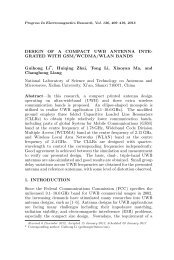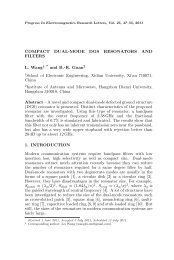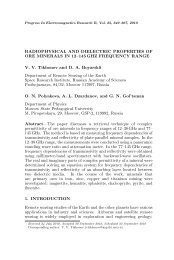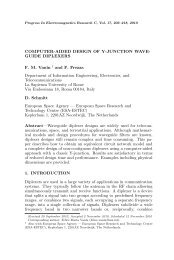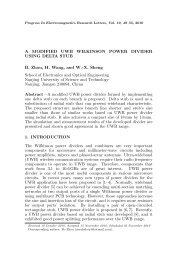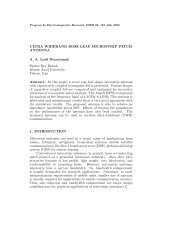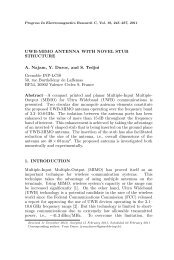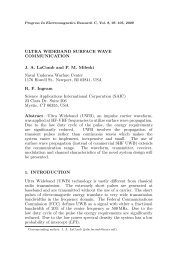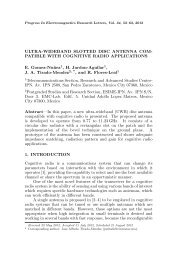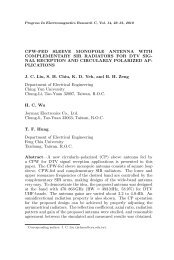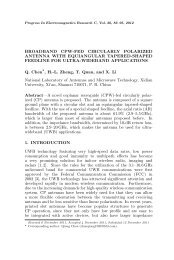LINEAR AND CIRCULAR ARRAY OPTIMIZATION: A STUDY ... - PIER
LINEAR AND CIRCULAR ARRAY OPTIMIZATION: A STUDY ... - PIER
LINEAR AND CIRCULAR ARRAY OPTIMIZATION: A STUDY ... - PIER
Create successful ePaper yourself
Turn your PDF publications into a flip-book with our unique Google optimized e-Paper software.
348 Khodier and Al-Aqeel<br />
methods [16]. These methods include neural networks (NN) [17–<br />
19] and evolutionary algorithms such: genetic algorithm (GA) [20–<br />
32], simulated annealing (SA) [33–36], differential evolution (DE) [37],<br />
and Tabu search (TS) [38]. The advantages of using stochastic<br />
methods are their ability in dealing with large number of optimization<br />
parameters, avoiding getting stuck in local minima, and relatively easy<br />
to implement on computers. Another recently invented evolutionary,<br />
high-performance algorithm is the particle swarm optimization (PSO)<br />
method introduced in [39, 40]. It requires fewer lines of code than GA<br />
or SA and easier to implement. Another advantage of PSO against GA<br />
is the small number of parameters to be tuned. In PSO, the population<br />
size, the inertial weight and the acceleration constants summarize the<br />
parameters to be scaled and tuned, whereas in GA the population size,<br />
the selection, crossover and mutation strategies, as well as the crossover<br />
and mutation rates influence the result [41]. Also, [41] shows that PSO<br />
algorithm convergence is faster than GA and SA for the same problem<br />
and the main computational time is lower than SA, binary GA, real<br />
GA, binary hybrid GA, and real hybrid GA. The literature on the<br />
use of the PSO method in the design of antenna arrays is extensive, a<br />
sample of which can be found in [42–57]. In this paper, the method of<br />
PSO is used to provide a comprehensive study of the design of linear<br />
and circular antenna arrays. The parameters of antenna elements<br />
that provide the goal radiation pattern are optimized using the PSO.<br />
The effectiveness of PSO for the design of antenna arrays is shown<br />
by means of numerical results. Comparison with other methods is<br />
made whenever possible. The results reveal that design of antenna<br />
arrays using the PSO method provides considerable enhancements<br />
compared with the uniform array and the synthesis obtained from other<br />
optimization techniques.<br />
2. <strong>LINEAR</strong> ANTENNA <strong>ARRAY</strong><br />
An 2N-element array distributed symmetrically along x-axis is<br />
considered as shown in Figure 1. The array factor is<br />
AF (φ) = 2<br />
N�<br />
In cos[kxn cos(φ) + ϕn] (1)<br />
n=1<br />
where k is the wavenumber, and In, ϕn and xn are, respectively, the<br />
excitation amplitude, phase, and location of element n. The element<br />
number 1 (n = 1) is placed at x1 = λ/4.





